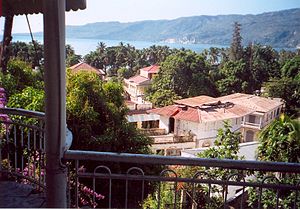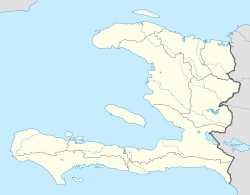Jacmel
Jacmel Jakmèl (Haitian Creole) | |
|---|---|
 View of Jacmel. | |
| Nickname(s): Culture Capital, City of Artists | |
| Coordinates: 18°14′7″N 72°32′12″W / 18.23528°N 72.53667°WCoordinates: 18°14′7″N 72°32′12″W / 18.23528°N 72.53667°W ⧼validator-fatal-error⧽ | |
| Country | Haiti |
| Department | Sud-Est |
| Arrondissement | Jacmel |
| Demonym | Jacmelien(ne) |
| Founded by Spain | 1504 |
| French settlement | 1698 |
| Founded by | Nicolás de Ovando |
| Government | |
| • Mayor | Marky Kessa |
| Population (2019)[1] | |
| • Total | 137,966 |
| Time zone | UTC-5 (Eastern) |
| • Summer (DST) | UTC-4 (Eastern) |
Jacmel (French pronunciation: [ʒakmɛl]; Haitian Creole: Jakmèl) is a commune in southern Haiti founded by the Spanish in 1504[2] and repopulated by the French in 1698. It is the capital of the department of Sud-Est, 24 miles (39 km) southwest of Port-au-Prince across the Tiburon Peninsula, and has an estimated population of 40,000, while the commune of Jacmel had a population of 137,966 at the 2003 Census. The town's name is derived from its indigenous Taíno name of Yaquimel. In 1925, Jacmel was dubbed as the "City of Light," becoming the first in the Caribbean to have electricity.[3]
The city is known for its well-preserved French Colonial architecture built in the early 19th century. The town has been tentatively accepted as a World Heritage Site. It sustained damage in the 2010 Haiti earthquake.[4]
- ↑ "Population of Cities in Haiti (2019)". worldpopulationreview.com. Retrieved 2019-03-23.
- ↑ Carl Ortwin Sauer (2008). The Early Spanish Main. New York: Cambridge University Press. p. 153. ISBN 978-0-521-08059-0. Search this book on

- ↑ Leeder, Jessica (2012). "Lighting the way forward in Haiti". The Global and Mail.
- ↑ "Heritage in Haiti". UNESCO.org. 2010-01-20.

